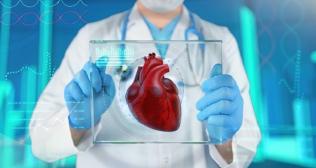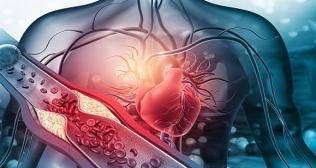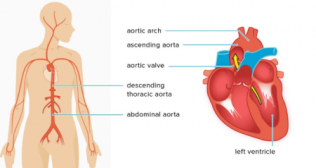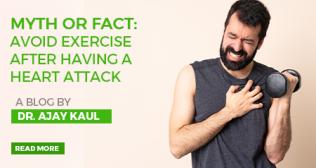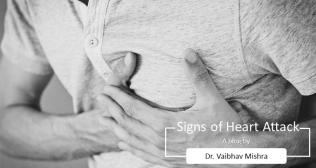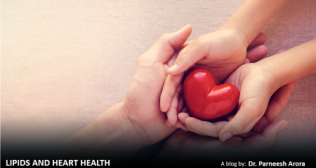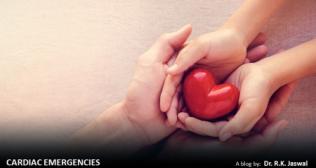
Cardiac Arrest - Dr. Vivek Kumar
Cardiac arrest is the abrupt loss of heart function, breathing and consciousness. In cardiac arrest the heart suddenly stops pumping blood round the body, commonly because of a problem with electrical signals in the heart.When the heart stops pumping blood, the brain is starved of oxygen. This causes unconsciousness, unresponsiveness and the breathing stops.
A cardiac arrest is a medical emergency. If you witness a cardiac arrest, you can increase the person’s chances of survival by phoning emergency services immediately and giving Cardio – Pulmonary resuscitation (CPR).
What causes a cardiac arrest?
The most common cause of a cardiac arrest is a life-threatening abnormal heart rhythm called ventricular fibrillation (VF).
Ventricular fibrillation happens when the electrical activity of your heart becomes so chaotic that the heart stops pumping and quivers or 'fibrillates' instead.
Heart-related causes of cardiac arrest:
- Coronary heart disease ( Blockages in the arteries of the heart)
- Cardiomyopathy ( Diseases of the muscle of the heart)
- Congenital heart disease ( Diseases present since birth)
- Heart valve disease ( Especially the narrowing of the valves)
- Acute myocarditis (inflammation of the heart muscle)
- Heart conduction disorders that make you more likely to experience abnormal heart rhythms, such as Long QT syndrome.
Other causes of cardiac arrest:
- Drowning
- Drug Overdose
- Electrocution
- Severe haemorrhage – losing a large amount of blood
VF can sometimes be corrected by giving an electric shock through the chest wall, by using a device called a Defibrillator. This can be done by a member of the public (using a public access defibrillator), the emergency services or at hospital.
In the absence of a defibrillator, ‘Thump version’ can be tried before commencing CPR. In a precordial thump, a provider strikes at the middle of a person's sternum (breast bone) with the ulnar aspect of the fist. The intent is to interrupt a potentially life-threatening rhythm. The thump is thought to produce an electrical depolarization of 2 to 5 joules.In preparation for the precordial thump, a firmly clenched fist is made and the arm held approximately 20 centimeters above the patient. After striking, immediately remove the hand to allow for chest recoil.
Immediate CPR will keep oxygen circulating around the body until a defibrillator can be used and/or until the emergency services arrive.
Cardiopulmonary resuscitation (CPR):
Begin CPR with chest compressions. Remember, the difference between your doing something and doing nothing could be someone's life.
CPR can keep oxygenated blood flowing to the brain and other vital organs until more definitive medical treatment can restore a normal heart rhythm.
When the heart stops, the lack of oxygenated blood can cause brain damage in only a few minutes. A person may die within eight to 10 minutes.
Remember to spell C-A-B
C-A-B — compressions, airway, breathing — to help people remember the order to perform the steps of CPR.
Chest compressions
Open the airway
Rescue breathing
Compressions: Restore blood circulation
- Put the person on his or her back on a firm surface.
- Kneel next to the person's neck and shoulders.
- Place the heel of one hand over the center of the person's chest, between the nipples. Place your other hand on top of the first hand. Keep your elbows straight and position your shoulders directly above your hands.
- Use your upper body weight (not just your arms) as you push straight down on (compress) the chest at least 2 inches (approximately 5 centimeters) but not greater than 2.4 inches (approximately 6 centimeters). Push hard at a rate of 100 to 120 compressions a minute.
- Continue chest compressions until there are signs of movement or until emergency medical personnel take over
Airway: Open the airway
- If you're trained in CPR and you've performed 30 chest compressions, open the person's airway using the head-tilt, chin-lift maneuver. Put your palm on the person's forehead and gently tilt the head back. Then with the other hand, gently lift the chin forward to open the airway.
Breathing: Breathe for the person
- With the airway open (using the head-tilt, chin-lift maneuver), pinch the nostrils shut for mouth-to-mouth breathing and cover the person's mouth with yours, making a seal.
- Prepare to give two rescue breaths. Give the first rescue breath — lasting one second — and watch to see if the chest rises. If it does rise, give the second breath. If the chest doesn't rise, repeat the head-tilt, chin-lift maneuver and then give the second breath. Thirty chest compressions followed by two rescue breaths is considered one cycle. Be careful not to provide too many breaths or to breathe with too much force.
- Resume chest compressions to restore circulation.
- As soon as an automated external defibrillator (AED) is available, apply it and follow the prompts. Administer one shock, then resume CPR — starting with chest compressions — for two more minutes before administering a second shock. Continue CPR until there are signs of movement or emergency medical personnel take over.
Categories
Clear allMeet the doctor
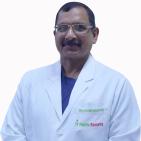
- Cardiac Sciences | Non-Invasive Cardiology
-
21 Years
-
1500







